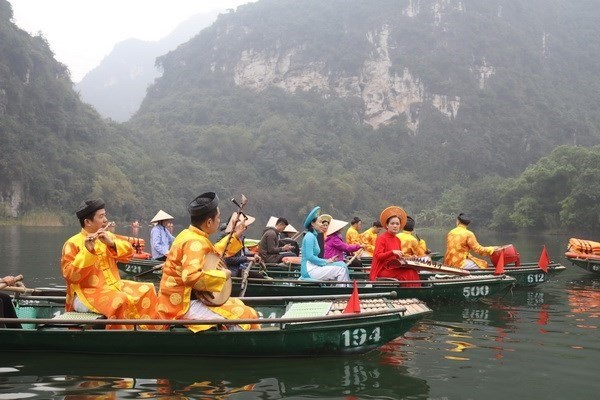



A royal court music performance in the new boat tour in Trang An
Complex. (Source: VNA)
The new waterway tour, the third of its kind, offers tourists a
scenic boat trip of three hours through the Trinh and Quy Minh temples and
caves of May, Dia Linh, Van and Dai. During the tour, visitors also have chance
to stop at the Vu Lam Palace and Kong film shooting site then return
to the departure point.
With the new waterway route tour, which opened in February with a ticket price
of 200,000 VND (9 USD) per person, Trang An now has three waterway tours and
one road route to serve visitors.
The tours offer the chance to visit up to 11 caves, temples and pagodas
including the Trinh Temple and picturesque mountainscapes. The river water is
clear enough to view aquatic plants living on the river bed. The nature is
pristine with forested mountains and green valleys of reeds and bushes.
The new route is not a difficult trek but includes walks to the Tran Temple,
the Vu Lam worshipping palace of the Tran dynasty and to Kong Village, a
recently built model aboriginal community with many simple bamboo huts and
friendly local villagers – just like the village you see in the latest Kong
film: Kong: Skull Island.
Nguyen Van Duong, a freelance tour guide specialising in Ninh Binh boat tours,
told Vietnam News that like many other tours in the province, including
those through Tam Coc and Bich Dong Complex, the new boat tour in Trang An was
obviously attracting visitors to the area.
Duong said along with stops at spiritual and historical vestiges such as the
Trinh and Quy Minh temples, the new stop at the Kong film studio on the tour
was attracting foreign and international visitors seeking to satisfy their
curiosity and admire the natural beauty of the complex.
The Trinh temple has a history of more than 1,000 years while the Quy Minh
temple has been recently restored.
Those interested in history will be attracted to the Vu Lam military base,
built by the first emperors of the Tran dynasty (1225-1400) after they defeated
Mongol invaders.
Caves, especially May Cave with its different stalactites, and Dia Linh Cave,
the longest in Trang An at 2km and featuring a pristine beauty, provide
adventure trips for those interested in exploration.
Director of the provincial Tourism Department Bui Thanh Dong told Dan Tri
online newspaper that this year the province expected to welcome 7.2 million
tourists and gross a turnover of 2,700 billion VND (117 million USD).
The new waterway tour is the first step in the province’s plan to increase the
number of tourists, particularly those who wanted to follow adventurous tours,
Dong said.
Nguyen Thanh Trang, a business representative from the agency C-Vietnam Travel,
said positive signs had been recorded in tourism development since Ninh Bình
has attracted more interest thanks to local historical and cultural vestiges as
well as well preserved natural beauty and eco-systems.
Located about 90km south of Hanoi, Ninh Binh is known as "Ha Long Bay on Land”,
given its limestone mountains rising out of paddy fields.
The most famous local attraction is the Tràng An Landscape Complex, which has
been expanded over recent years and gained popularity for its green fields,
mountains, caves and forests.
The province has been listed as one of the 50 best spots to visit in 2018 by US
travel site Insider.
Together with other famous sites in the province such as Tam Coc Grottos and
Van Long Lagoon, the Trang An Landscape Complex was also used as a location for
the movie Kong: Skull Island, one of the biggest Hollywood blockbusters of
2017.
The locations opened to tourists last April.
Ninh Binh welcomed over 7 million visitors last year, up nearly 10 percent
against 2016, of which international visitors were nearly 860,000.
The Trang An tourism complex has a total of 40 tourism spots of historical,
cultural, art and natural vestiges including 20 recognised as national
heritages.
In 2014, it was officially recognised as a mixed cultural and natural heritage
by UNESCO thanks to its outstandingly natural & cultural values.
In UNESCO’s words, "Trang An is a resplendent complex of limestone karst
peaks which are permeated with valleys, including submerged ones, and
surrounded by steep, almost vertical cliffs", nestling on the southern
shore of the Red River Delta.
Archaeological traces of human activity dating back thousands of years have
been found within the complex.
The Trang An Complex boasts several nationally recognised sites like the Trang
An ecotourism site and Hoa Lu, Vietnam's capital in the 10th and 11th
centuries.
The area also has many temples, pagodas, paddy fields, villages and other
sacred sites.
It is home to about 500 flora species, 73 species of birds and 41 species of
other animals and has a diverse ecosystem.
Source: VNA